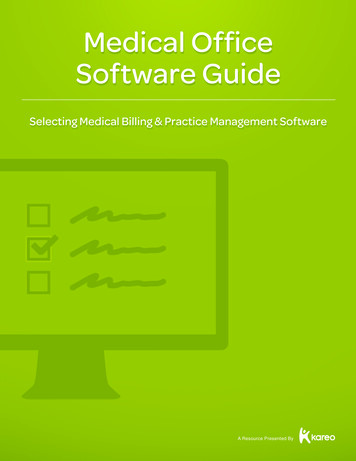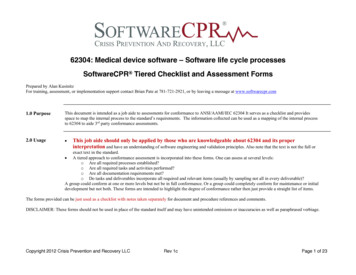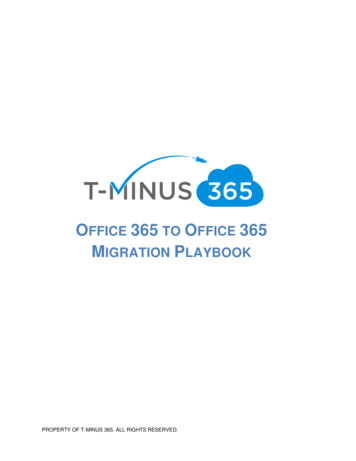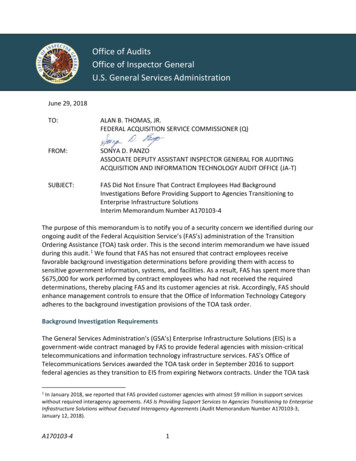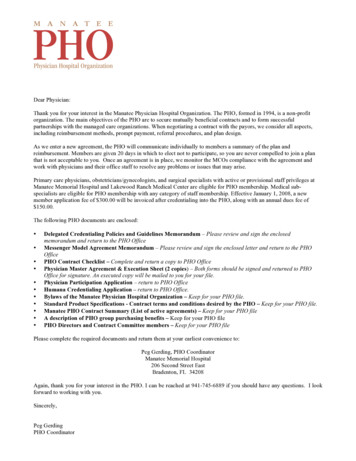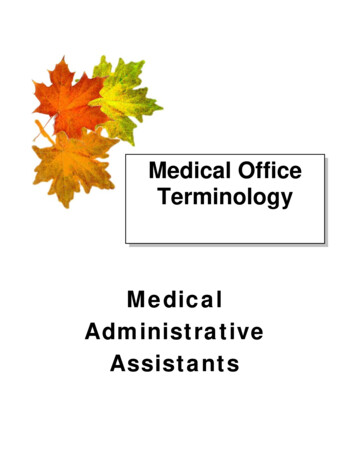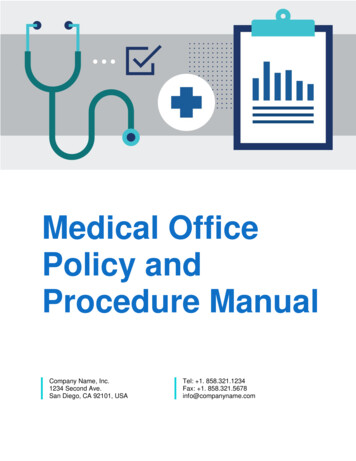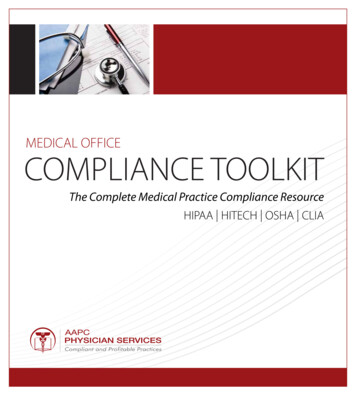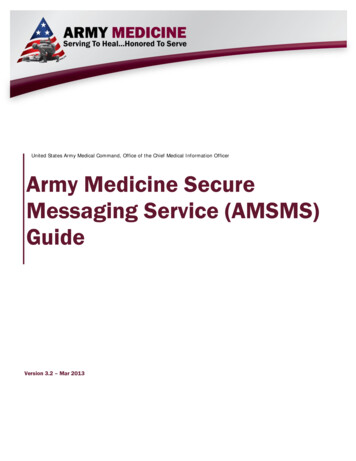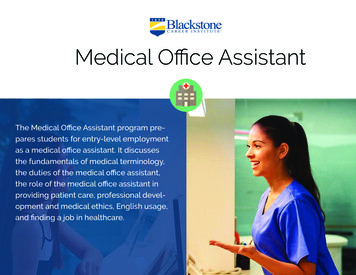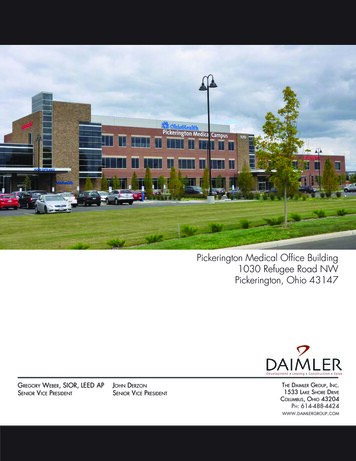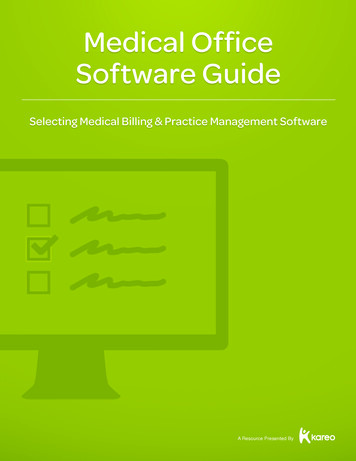
Transcription
Medical OfficeSoftware GuideSelecting Medical Billing & Practice Management SoftwareA Resource Presented By
Contents1Guide to Selecting Medical Billing and PracticeManagement Software1Step 1 – The Feature Guide4Step 2 – The Vendor Guide6Step 3 – Guide to Measuring Your Success6Tools for Measuring Success8The Essential Questions
Guide to Selecting Medical Billing and Practice Management SoftwareGuide to Selecting Medical Billing and PracticeManagement SoftwareChoosing the best Practice Management (PM) software is singularly the most importantdecision the ambulatory provider practice will ever make. In the US healthcare system,providers are compensated on a fee for service basis. Having an ability to move patientsthrough your practice easily and efficiently needs to be of primary concern when a providerbegins a practice. Thankfully, PM software facilitates this move of patients through theoffice and does so by adding efficiency in the following core components of the practice: Registration Scheduling Charge entry Payment posting Insurance & Patient Billing ReportingStep 1 – The Feature GuideThe first step in the evaluation of any good PM system is to verifythat the above components exist, are easy to learn, and scalableas your practice grows. Without these core functions, a practicecan in no way survive billing and receipt of payment for more thana very small number of patients. Certainly, prior to the advent ofPM systems, there were systems in place to help move patientsthrough a practice; however, the process of reimbursement as it becomes more and moreregulated has made the utility of a paper based office a thing of the past.Each component above should be evaluated firstly for feature function. This is not tosay that one should select a system based upon the most bells and whistles, but ratherthat one should select their PM system based upon the exact needs of the practice. Ananesthesiology practice has dramatically different billing requirements than a pediatrician.Each feature needs to fit within the workflow of your type of practice. This being said,there are overlaps and commonalities that should be looked for to help you decide whichsystem works best.1www.kareo.com
Guide to Selecting Medical Billing and Practice Management SoftwareRegistration includes several features that can make system selection easier. Beyondthe basic patient address, employment, and insurance information, the software shouldaccommodate today’s patient – one with multiple phone numbers, emails, and frequentaddress changes. Under registration, also check for integrated insurance eligibility. Greatsoftware will give you flexibility on when and how often the automatic eligibility verificationis done. Make sure on-demand checking is possible at multiple points along the patientflow process – when the patient schedules the appointment, before they show up at theoffice, when they present in the waiting room, and even just before the claim is sent. Theextent to which you use the eligibility checking will vary depending upon your patientpopulation, but having the capability and flexibility is important.Scheduling should be easy to learn, intuitive, allow you to schedule patients fordifferent time blocks, easily and quickly, and should facilitate rapidly changing appointmentlocations, times and should integrate with the provider’s daily schedule. Don’t be fooled bygimmicks here, drag and drop scheduling sounds like a great idea and demonstrates reallywell; however, most practices couldn’t possibly keep every day where there is an open slotwith a provider on one page. Look instead for a system that has an ability to lock in on apatient and keep them in focus until you have located the appropriate slot for them.Charge entry means not only actual entry of CPT codes and associated diagnosiscodes, but the creation of a claim form that can be sent by paper or electronically. Makesure that the system you are evaluating can do both. When researching the basic dataentry of procedures, make sure quick keyboard entry is inherent in the system. A featureyou’ll see from good, experienced software is the ability to create and enter macrosthat give you quick entry of multiple codes through only keying in a single code. Moreadvanced systems will build in coding rules and perform an on-demand validation thatthe codes entered make sense when compared to general coding edits. This is oftencalled “code scrubbing.” The last mission critical piece is ability to communicate thisclaim information electronically. When sending claims electronically, ask what insuranceplans the software can connect to. Which of those plans can offer electronic eligibilityverification? Which plans offer Electronic Remittance Advice? Make sure the plans yourpractice interacts with most have these electronic connections.2www.kareo.com
Guide to Selecting Medical Billing and Practice Management SoftwarePayment posting includes the ability to manually enter checks you receive frominsurance carriers to full electronic remittance advice (ERA). ERA has come a longway from the early nineties. Now, most payers offer the ability to send their checkselectronically, with partial billing, claim denials and other line item posting features allvia an electronic file that should post very easily and quickly. Embracing these types offeatures into your workflow will save you and your staff a lot of time.Insurance & Patient Billing is considered a portion of the total payment postingprocess. Does your PM system have an ability to manage those claims that remainunpaid or those that have switched financial responsibility to the patient? The ability notonly to send statements, but different statements on different cycles that say differentthings, all related to how old a claim balance is, or how long it’s been since a payment hasbeen received are really great features to have. Sometimes, integrated letter writer or mailmerge feature allows you to send targeted statements and collections letters to patientswho are delinquent or those who are on payment plans. Features vary widely, but this is areally nice thing to have.Reporting is one of the major features and benefits that can really make a hugedifference between PM systems. How flexible are the reports that come with the system?Can you target AR days? Can you show productivity reports? Can you look at collectionsby payer? Collections by referring provider? Posting lag? The specifics are varied basedupon your type of practice; however, the best rule is to take a look at the reports includedin the PM system you are evaluating and see if they look like they would be helpful to youin running your business.3www.kareo.com
Guide to Selecting Medical Billing and Practice Management SoftwareStep 2 – The Vendor GuideNow you know what features should be included, but what aboutthe vendor? Another important piece of information that oneshould consider when selecting a PM system is the vendor fromwhom you are buying it.Questions to consider: Are they the creators of the product? Are they a reseller of someone else’s product? How is the product installed? How much does the product cost to get started and in the future? How is the product supported?These are all mission critical questions one should ask the vendor before any decision ismade.Resellers are not good or bad. This simply means that they did not make the productand may only sell, install it, or support it. They may have other services that they offeronce the software is installed. While resellers have good points, it is important to knowthat there are other considerations as well. They didn’t make the product. Ultimately,supportability can be a challenging if the source of the issue or error is not easy todecipher. Use of a reseller raises the likelihood of a finger pointing nightmare of technicalsupport. It is because of this main issue that most practices choose to purchase softwareand services directly from the creator of the PM software.Cost? Assuming that you are evaluating solutions that are not being resold, the firstquestion one should ask is how much does it cost? Cost is also an ongoing thing. Howmuch does the system cost, up front, and how much does it cost on an ongoing basis? Isit a transactional model whereby every click or claim is charged? Is it charged on a perprovider basis or a per seat/user basis?Cloud-based or Shrink wrapped? Once you have figured out what your costs willbe, the next most important question is how will you install the software? Is it something4www.kareo.com
Guide to Selecting Medical Billing and Practice Management Softwarethat is shrink wrapped and shipped to you? Or is it cloud based system that requires adownload or a login?If you choose a software that is shrink wrapped and loaded on your local computers,consider that the total cost of ownership has just dramatically increased! You will beresponsible for loading the software correctly. You will be responsible for all updates tothe software. You will be responsible for performing a nightly backup These days,most vendors offer some form of cloud based or internet based solution. For the cloudbased internet option, always check with the vendor about how they handle ownershipof data, how data is stored, how backups and disaster recovery are handled. Once youhave verified that the company you are working with is aware of HIPAA and has a cogentdefinable plan in place regarding the physical safety of your data (and your access to saiddata) this is clearly the easier way to go.Here to stay? This brings back the question of who the vendor is. How manycustomers do they have? Do they have enough customers so that they will remain inbusiness for five to ten years, or are they so large that you may get lost? A good vendorshould be there to hold your hand during not only the sales process, but the installation,training and support process. They should offer services like data migration, back officebilling services, AR management and they should not nickel and dime you for every phonecall you make for support of the product.Ask the vendor what other services they offer. Often, there are a suite of services thatyou would never know about unless you asked. These services should include not onlyback office administration services, but workflow optimization, HL7 connection, hospitalinterfaces, lab interfaces, etc.EHR Connectivity? Next, one should also ask what EHR system is integrated withthe PM system. Today, most PM systems are selected as an afterthought of an EMRinstallation. Don’t fall into that trap. Find out ahead of time what systems work withyour current PM or the one you are looking to implement. Typically, PM software willoffer several options to connect to various EHRs or have an embedded EHR. Thoughhaving the EHR and PM as a single system is talked about a lot, common “app for that”philosophies today have proven that practices can select an EHR specific to their specialtyor price-point and have data shared with the PM software of their choice. Either way, EHRconnectivity is the key.5www.kareo.com
Guide to Selecting Medical Billing and Practice Management SoftwareStep 3 – Guide to Measuring Your SuccessCongratulations! Making the practice management decision is thesingle most important piece of technology for your practice. Sinceyou have, selected a PM solution, pick some key metrics you wantto track, get the system up and running and be sure to have acheck in meeting with your vendor every three months for the firstyear and then once every six months thereafter. This way, you can not only see if you aremeeting your targeted metrics, but also uncover new metrics you may want to pursue.Here are some tools to help track your progress and overall business efficiency.Tools for Measuring SuccessPM Vital Signs Tracking WorksheetMeasuresBefore theChange3 MonthsAfter6 MonthsAfterDays in AR(# days from time of billing totime of payment – on average)Payment Velocity(# days from date patient wasseen to the time of payment –on average)Posting Lag Time(amount of time betweenpatient visit and chargeposting)6www.kareo.com
Guide to Selecting Medical Billing and Practice Management SoftwareInsurance Productivity ChartInsurance PlanTotalCharges(last 12 months)Total Patients(last 12 months)TotalPayments(last 12 months){ insert plan }Referring Doctor Analysis ChartReferring Doctor orOrganizationTotal No.Patients(last 12 months)TotalAssociatedCharges(last 12 months)TotalAssociatedPayments(last 12 months){ insert referring doctor }7www.kareo.com
Guide to Selecting Medical Billing and Practice Management SoftwareThe Essential QuestionsAnswering the following essential questions will help form the foundation of an informedselection process.Features: Are these basic features included? Scheduling Charge entry Payment entry Eligibility verification ERA (Electronic Remittance Advice) Collections ManagementººUnpaid Insurance ClaimsººPatient Due Accounts Receivables Productivity reportsSales & Service Work directly with the software maker? Work through a reseller of the software?Types of Software Is cloud-based software for me? Is a traditional installed client-server software for me?Software Maker’s Experience & Level of SupportNumber of customers?Number of practices like mine?Types of billing handled? HCFA1500 UB92References or testimonials?Yes8Nowww.kareo.com
Guide to Selecting Medical Billing and Practice Management SoftwareThe Essential Questions (continuted)Able to work with me through transitions to their product(s)? Data migration Enrollment and setupEHR Connectivity OptionsIs the EHR a part of the PM system (“integrated”) and is that best for my practice?YesNoAre interfaces already built to my EHR or other potential EHRs?YesNoWhat is the Total Cost?Can I get a good system without it costing an arm and a leg?YesNoWhat’s my budget?What are the upfront costs of the software?What are the on-going costs of the software?9www.kareo.com
Guide to Selecting Medical Billing and Practice Management SoftwareAbout the AuthorStelle Smith is a Healthcare IT consultant with over 20 years of experience in both revenuecycle management and clinical workflow redesign and processing. Stelle has served notonly as an expert within the organizations he has worked for, presenting at many majorhealthcare conferences like HIMSS and MGMA, but has also served on several nationalcommittees in helping shape the landscape of healthcare IT adoption working on CCHITfor many years and serving as an adviser for many national, international and regionalintegrative healthcare initiatives like HIE programs, Meaningful Use and ComparativeEffectiveness. His web site is www.askStelleSmith.comAbout KareoKareo is committed to providing education and insights to small medical practices. Thecompany works with in-the-trenches influencers, consultants, and Kareo customers toprovide relevant tips on how to successfully manage medical practices and medical billingservices.10www.kareo.com
111 Academy, Suite 250 Irvine, CA 92618(888) 775-2736 www.kareo.com 2012 Kareo, Inc.
having the EHR and PM as a single system is talked about a lot, common “app for that” philosophies today have proven that practices can select an EHR specific to their specialty or price-point and have data shared with the PM software of their choice. Either way, EHR connectivity is the key.
